
This article is produced in partnership with the tourist association of the island of Sado, which invited us to discover their island. It reflects the experience we both experienced during our day and night on the island with complete freedom of expression.
If you love nature with a touch of culture, history and traditions, then you will succumb to the charms of the beautiful Sado island!
Located near the city of Niigata, on the northwest coast of Japan, this island has something to enchant all those who will one day set foot on it! This was our case when we discovered Sado Island during a trip organized in early November by the island's tourist association.
What a surprise it was to discover a preserved island, far from the hustle and bustle of the big Japanese cities, where traditional small wooden houses coexist with a nature that still seems untamed. Here the mountains are covered with a thick forest, rivers and waterfalls flow directly into the sea in the hollows of a wild coast jagged by the waves.
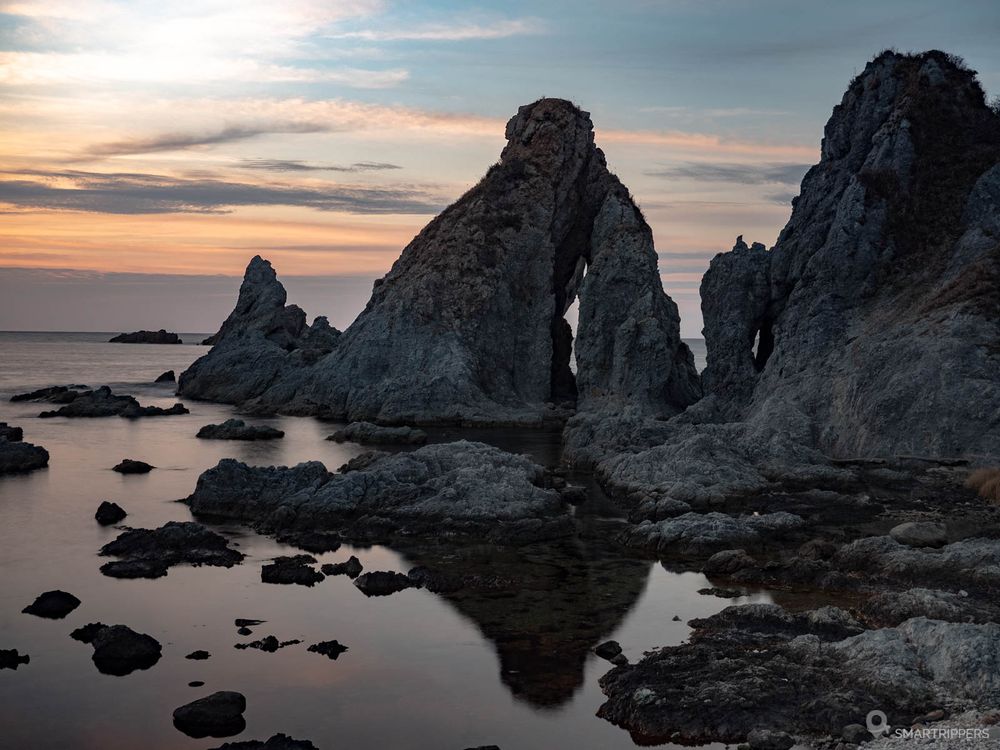
We came to take a breath of fresh air, of nature, but also of culture, history and traditions, because the island of Sado also revealed its past to us, at a time when gold was coveted in the mountains and many workers came to try their luck to collect a few nuggets.
We were only able to spend one day and one night on Sado Island, which only gave us time to discover the northern part of the island, but we promised ourselves to come back longer, so much we liked it! In this article, we will talk about the landscapes and historic sites we have discovered, but we will first start with some practical information.
Summary
1How to get to Sado island?
Several boat connections connect Sado Island to the various cities along Japan's northeast coast: Niigata, Jōetsu and the Teradomari terminal. Please note that depending on your port of departure, the ferry will drop you off at a different location on the island. In our case, we used the link from Niigata which took us directly to the port of Ryotsu, in the centre of the island.
From Niigata, the pier is located in the Bandaijima district. A bus connection is possible from Niigata Station. Once there, you will have to make a choice because there are two types of ferries.
- The traditional "car ferry", which takes passengers but also vehicles and makes the crossing in 2h30. Count 4690u00a5 per person for the round trip
- The jetfoil, for passengers only, which is much faster. Expect 1h05 for the crossing, but also a higher rate of 12080u00a5 per round trip.
To know more about the different rates, you can consult this page.
You can buy your tickets directly at the pier, but you must arrive about 30 minutes before the boat's departure. If several companies make the crossing as it is the case from Niigata, choose the right boarding area carefully, because each company has its own boarding area.


Once there, we recommend that you rent a car. Although a bus network allows you to tour the island, it will be more convenient to rent a car and take your time to stop as soon as you feel like it. You will easily find different rental agencies near each pier.
2Visit Sado Island: What to see, what to do?
Sado Island consists of 3 distinct parts:
- The northern part, mountainous, which extends from northeast to southwest
- The southern part, also mountainous and parallel to the northern part (the two parts were once two separate islands)
- The center of the island, a large plain called Kuninaka, bordered by the Ryotsu and Mano Bay, nestled between the two mountains and formed by the silt deposited here over the centuries, thus connecting the two islands. It is here that we will find the vast majority of the island's dwellings and crops.
In this chapter we will focus on the activities and points of interest in the northern part of the island, the only one we have had the opportunity to discover.
Uchikaifu Coast
The Uchikaifu Coast runs along the southeast of the North Island. Here, the tiny villages with old wooden houses follow one another along the coast. The shoreline is rather classic, but the narrow road along the sea already offers a pleasant feeling of escape. It takes about 1 hour to reach the northeast tip of the island from Ryotsu.
Futatsu-game
We are now close to the northeastern tip of the island. Here the coast is swept by winds and sculpted by waves. Don't miss a stop at Futatsu-game, the famous Sado rock connected to the shore by a thin strip of sand and pebbles that can be crossed on foot at low tide when the sea is calm. During the summer, the place is very popular with bathers. Moreover, a campsite allows you to pitch your tent just above the cliffs, from where a path leads down to the sea.
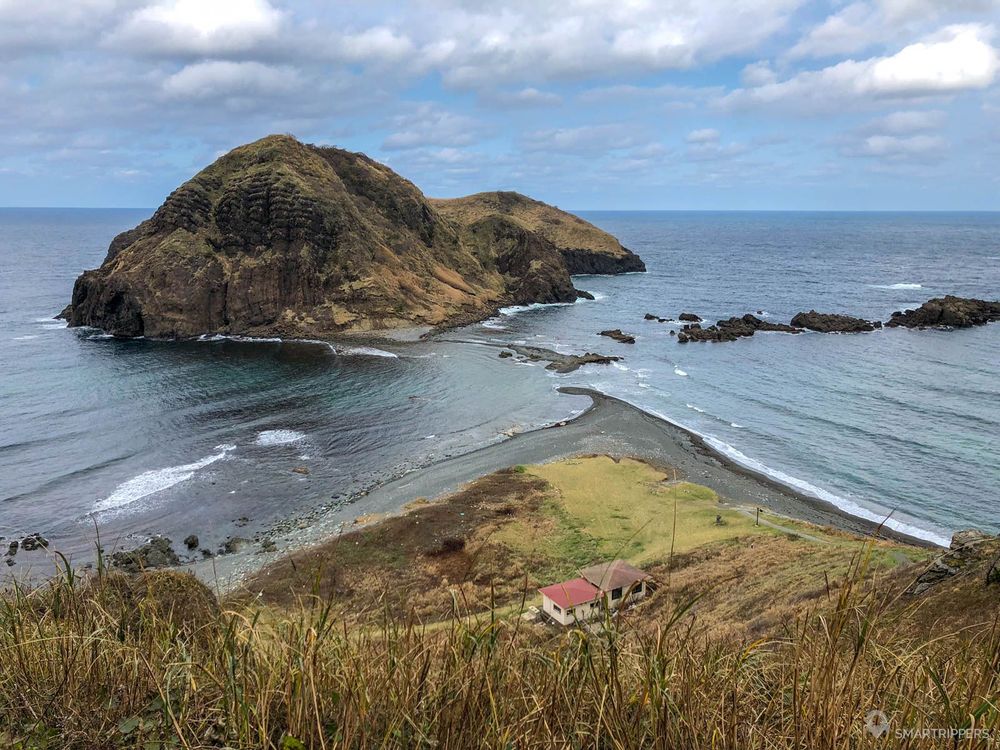
The site is well indicated and you will find a large parking lot. From here, go down the few steps to reach the beautiful viewpoint on the rock and its sandy strip (at the campsite). You can then choose to go down to reach the sandy strip.
In November, the sea was rather rough and the weather grey, which did not highlight the place, which must be very pleasant when the sun's rays illuminate the water. It seems that the colour of the water is very beautiful in summer. The beach and sandbank of Futatsu-game is one of the 100 most beautiful beaches in Japan selected by the Ministry of Environment.
Ono-game
Just after Futatsu-game is Ono-game, another large rock whose particularity is that it is covered with pretty yellow flowers at the beginning of June that bloom only in 2 places in Japan. A path used to climb to the top of Ono-game but it is now closed. Another path follows the coast between Ono-game and Futatsu-game. The place is particularly pleasant to walk around.
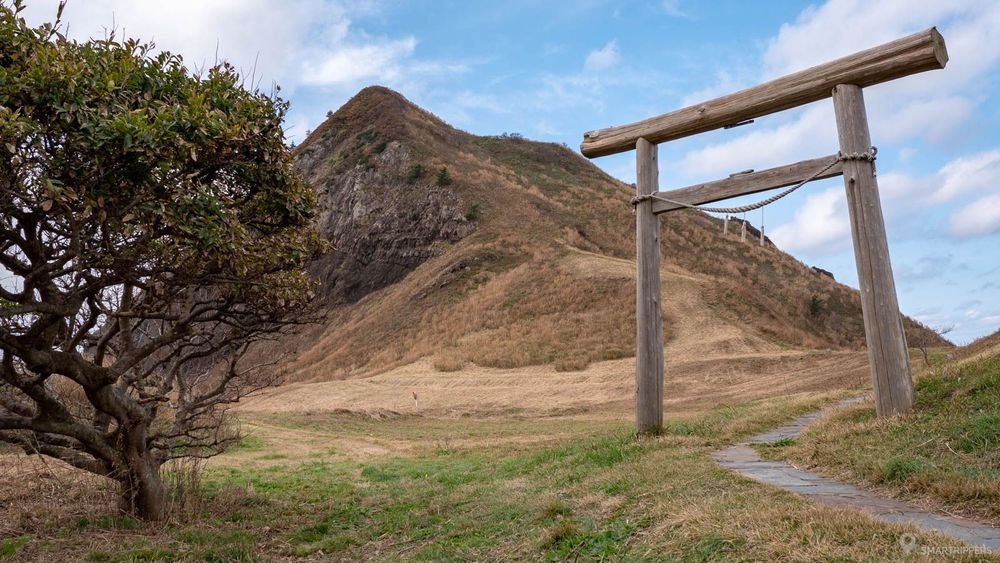
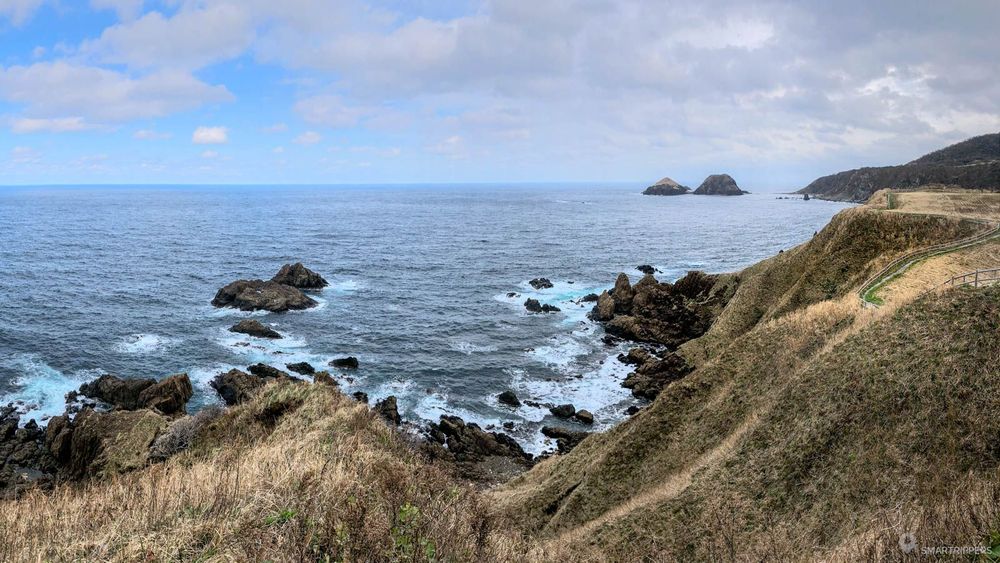
Sotokaifu Coast
The Sotokaifu Coast runs along the entire northern part of Sado Island. Here winds and waves have shaped the rocky coast creating a chaos of rocks scattered all over the coast. The small narrow road winds along the mountain, sometimes on its side and crossing some bridges and small rocky tunnels. This is the place we enjoyed the most on the island.
Let yourself be transported by the wild landscapes that this part of the island has to offer. Do not hesitate to park to enjoy the many panoramic views of the mountains or the sea. Allow 2 hours to walk along the entire coast.
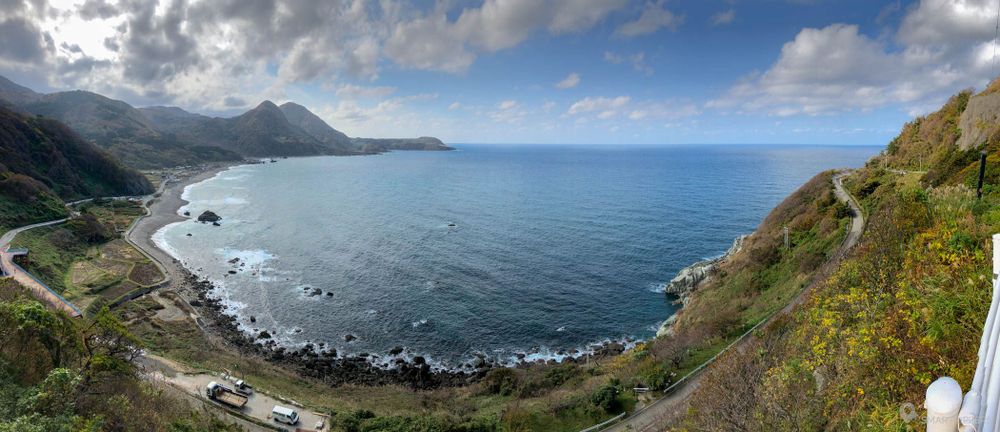
Senkaku-wan Bay
This is one of the most emblematic places on the island of Sado. Here the coast is torn apart to form a myriad of small islets, caves and sharp rocks. The bay has been protected by a national park and it is possible to discover the coastline by boarding a small boat with a glass bottom.

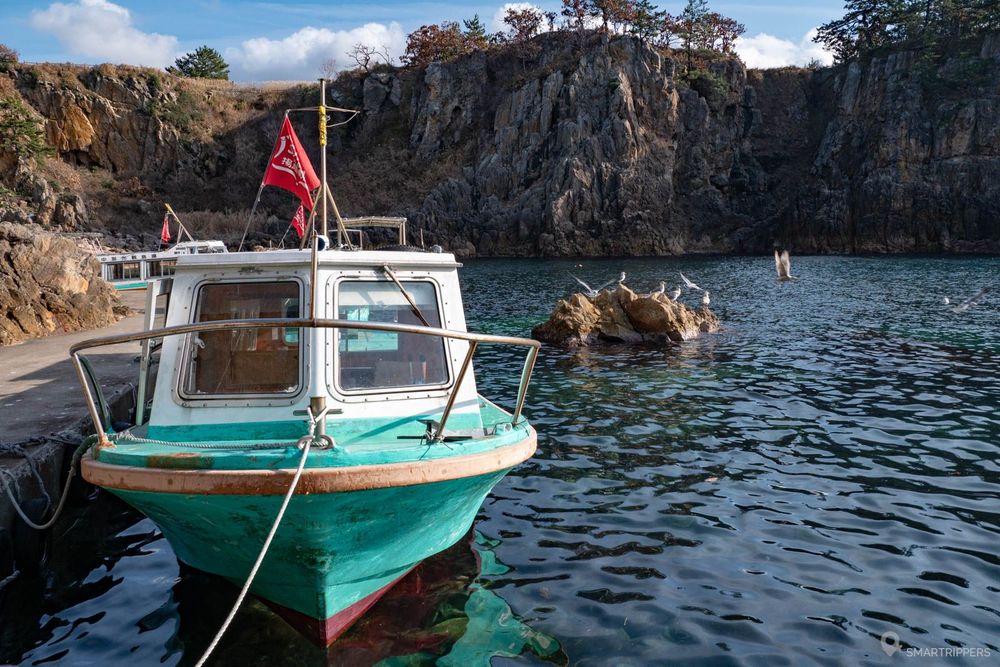

We tried the experience despite a very rough sea. We cannot say that the ride was calm, as we were tossed in all directions by the big waves, but the boat ride must be really pleasant on a calm sea day.
The small boat snakes between the pillars and approaches very close to the coast, until it reaches the small corners formed by the rocks. It allows us to explore both the details of the carved coast and the seabed through the glass in the middle of the boat.
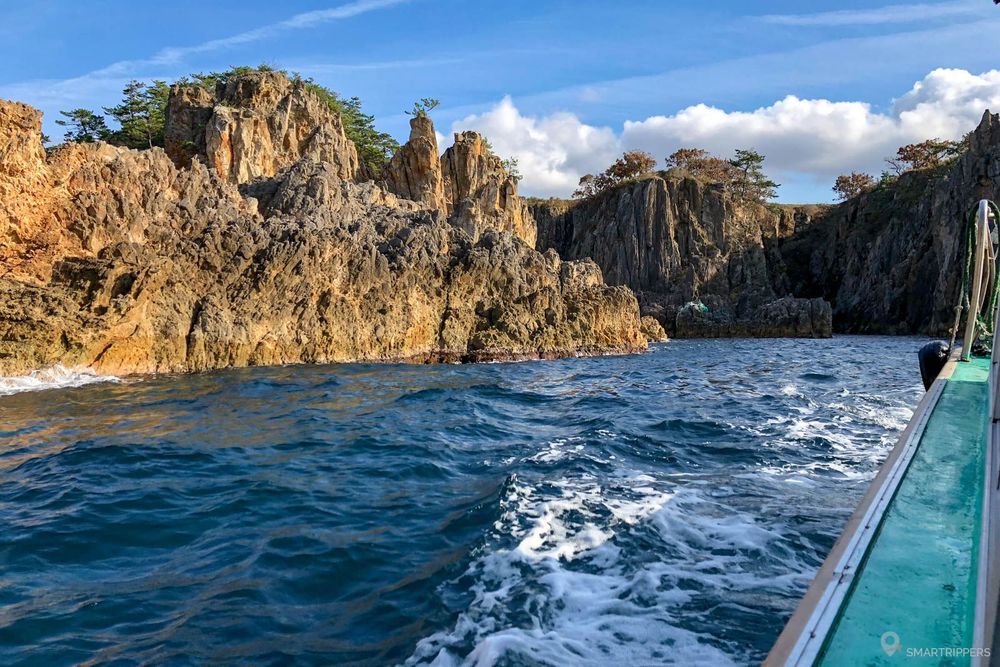

They are small boats that can accommodate 12 people. We are all sitting around the glass so that we can see the bottom. It was very clear and you could really see the bottom despite the waves. The cruise lasts 15 minutes.


Admission: 1100u00a5 per adult and 550u00a5 for children. Boat cruises are only possible from mid-March to the end of November.
If you are not interested in the cruise or if you come out of season, it is possible to access a viewpoint and a small aquarium for 550u00a5 entrance fee (280u00a5 for children). Their access is included in the ticket with the cruise.
The viewpoint is accessed from a concrete bridge that leads to the end of the small peninsula, at the end of which a large belvedere has been built.
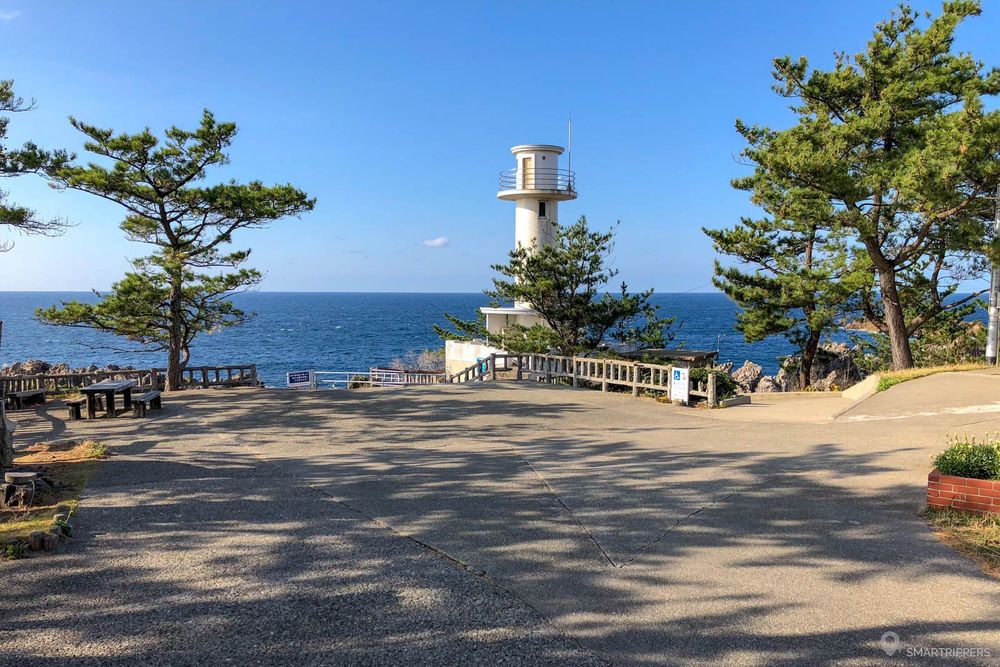
Finally, don't forget to stop at the small aquarium where many local fish and shellfish species are visible. You can easily observe the mimicry of a kind of fearful little squid, or have the little skins of your hands eaten by tiny, voracious fish.



The Sado Kinzan gold mine
Not far from the western end of the northern part of the island is a very interesting place: the Sado Kinzan gold mine. We must imagine being here in 1601 when the first gold mining activities began. Soon the golden veins of Sado Mountain attracted crowds. Many people wanted to take their chances and get rich, but few managed to do so.
The top of the small mountain above the gold mine is an excellent example of this incredible gold rush. On closer inspection, we notice that the upper end of the mountain is notched. The most surprising thing is that this large notch was dug by hand by the fiery gold diggers of the period! It took a good dose of madness to dig the mountain with just a few rudimentary hand tools.
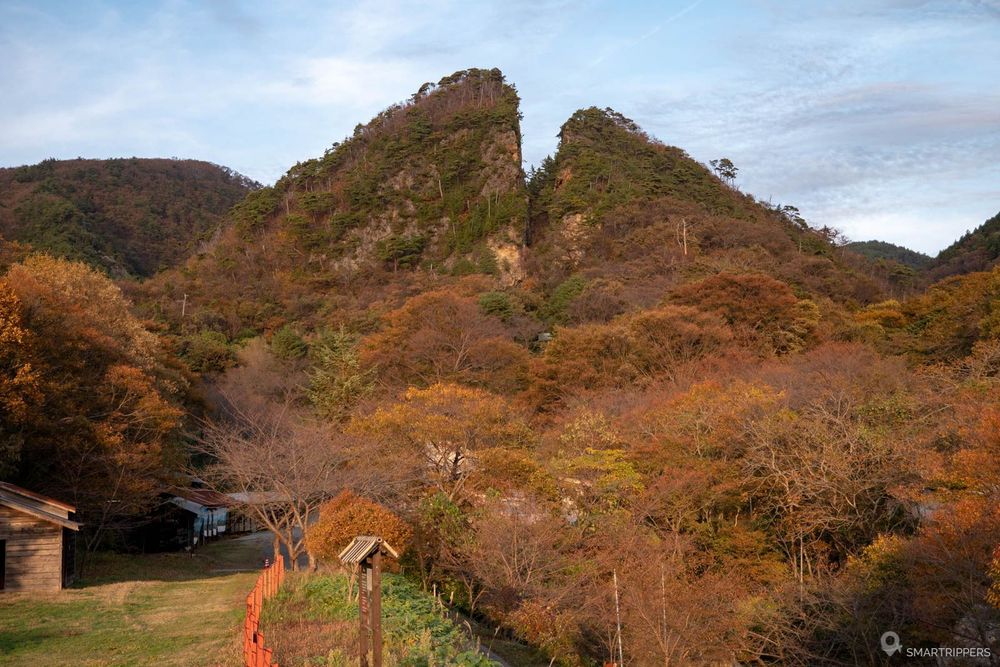
The mountain's golden veins were exploited for more than 400 years. In total, 400 kilometres of tunnels have been dug, some of them under very difficult conditions.
Today, some of these galleries can be visited on foot. There are 4 of them in total, including two portions that can only be explored on a guided tour with a helmet and lamps and by reservation only (these are the Mumyoi and Ogiriyama mines). The other two mines are open to the public and can be discovered without a guide.
We were able to visit the Sohdayu mine, whose casings were dug during the Edo era 400 years ago. In addition to walking through the tunnels, scenes from the exploitation of the time were reconstructed with automatons, which is very interesting (average duration of the visit: 30 minutes). The last mine, the Dohyu mine, is a more recent gallery that has been in operation for the past 100 years until 1989, when the mine ceased to operate (average visit duration: 40 minutes).



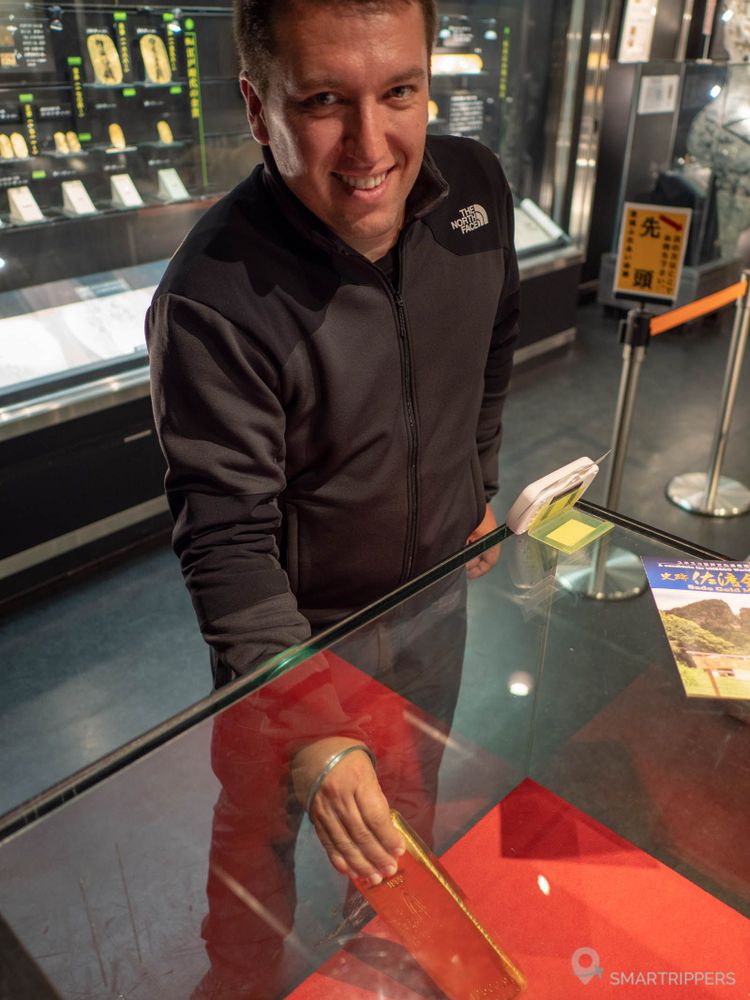
After visiting the galleries, you can access a very interesting small museum that recreates the city and life near the mine in the Edo era. You can also see the tools used at the time as well as some rock and gold fragments.
Another curiosity is that you can take a large gold ingot weighing about 12.5 kg in your hands! And know that if you manage to extract the ingot from its box through the small hole, you will win a nice certificate!
Once out of the museum, you enter a small and pleasant garden where the maples are magnificent in the fall, before returning to the mine's parking lot.
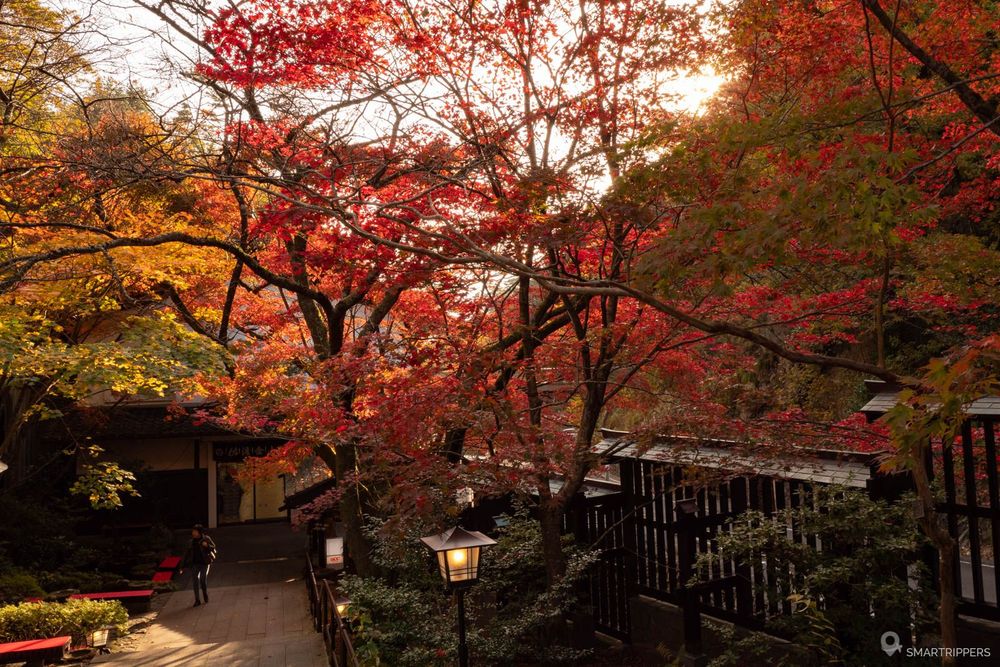

Practical information: The mine is open all year round. Access from 8:00 am to 5:30 pm from April to October and from 8:30 am to 5:00 pm from November to March. Access fees to the Sohday or Dohyu mine: 900u00a5/adult and 450u00a5/child or 1400u00a5/adult and 700u00a5/child to visit both mines.
For more information, see the Sado Kinzan gold mine website.
Kitazawa Flotation Plan
To complete the visit of the Kinza gold mine, it is possible to discover the still recent remains of the large infrastructure used for ore processing and to separate gold from rock, which were built in the 19th century and then gradually abandoned since the Second World War until their definitive closure in 1989.
Today, vegetation is gradually regaining its rights, invading each gap in the concrete and covering the buildings with a green mantle.
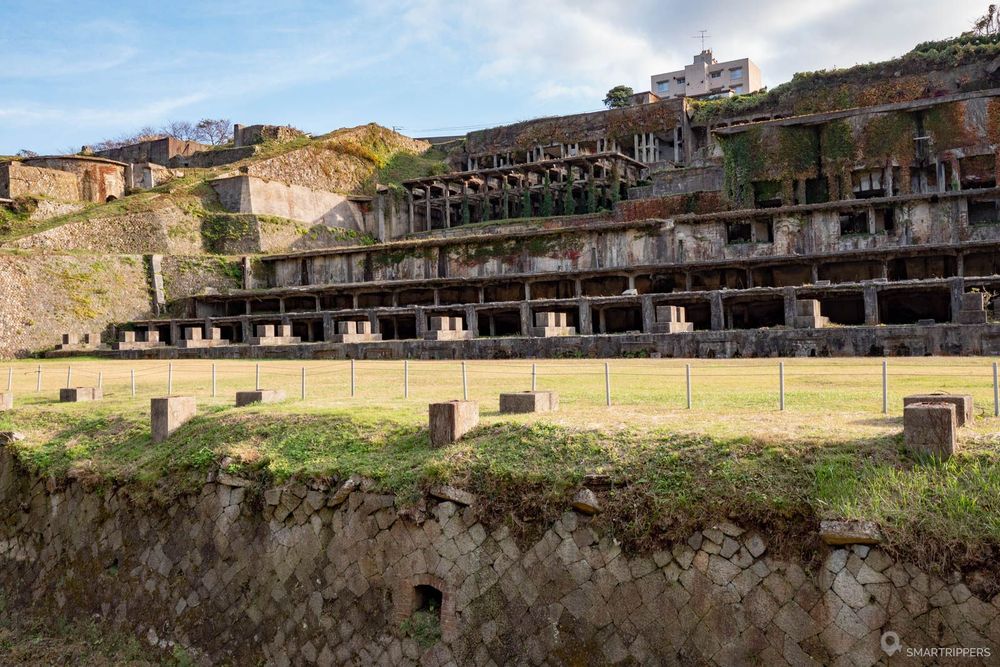
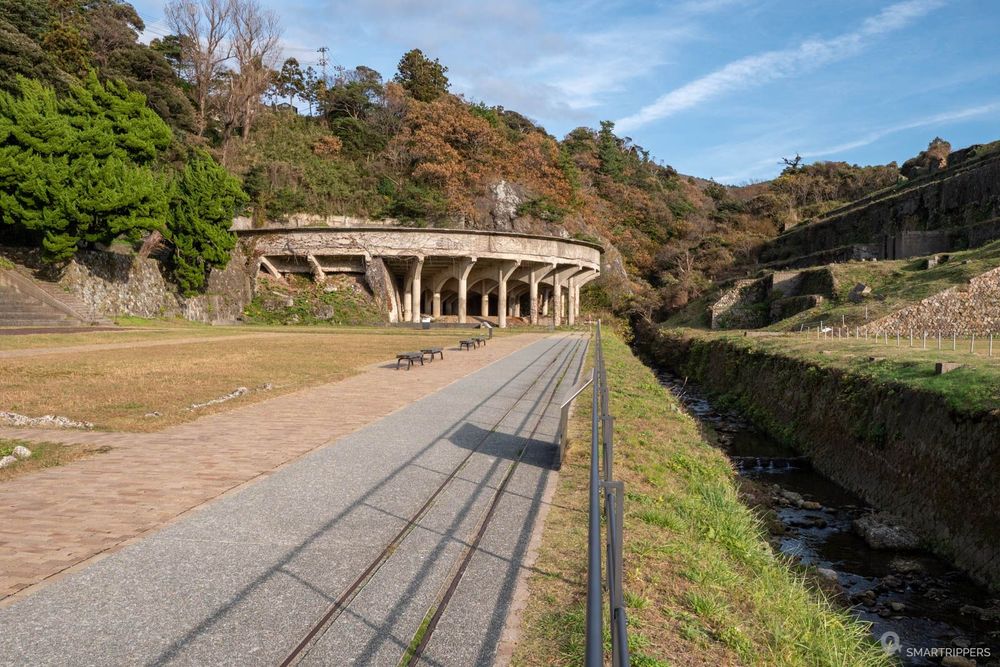
Also to visit
That concludes the list of points of interest that we were able to discover during our day in the northern part of Sado Island. There are also many activities and points of interest to see in the central and southern part of the island such as the Taraibune Tub Boat, small popular and traditional boats similar to wooden barrels that will allow you to sail on the water or discover one of the many temples or sanctuaries on the island such as the Miyoshoshi Temple and its 5-story pagoda. For more information, we recommend that you consult the official website of Sado Island, which is rich in information.
3Where to sleep in Sado?
The central area of the island offers the best place to sleep in Sado, so you will be in the heart of the island to easily reach the northern or southern areas.
We stayed at Kanazawaya Ryokan. It is a very old and charming building with large bedrooms (tatamis) located on the shores of Kamo Lake. We were warmly welcomed by the owners who bent over backwards to make us have a good stay. They only speak a few words of English but enough to locate the toilets, or understand the schedule of dinners and breakfasts, if you choose the formula with meals.
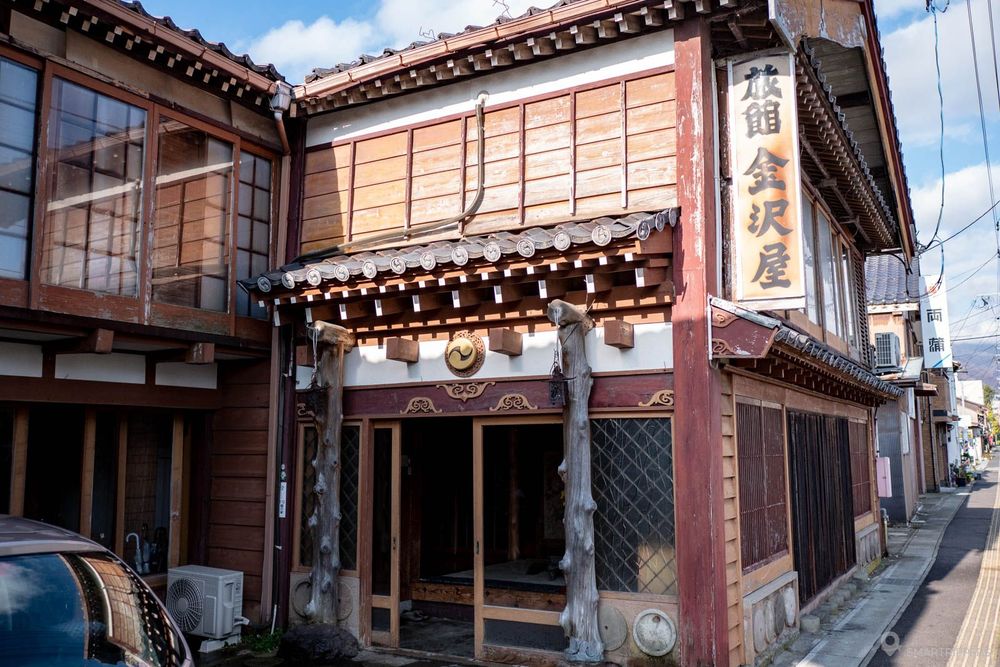


The rooms are very spacious with a tea table and another adjacent room just for the futons that were comfortable. We had a small private sink in our room. The men's and women's bathrooms have a small hot bath.


The Ryokan also has a garden that provides access to the shores of Kamo Lake. The owners even offered us shrimp cakes to feed the birds, a very pleasant experience in the early morning!
Meals are traditional meals with local products mainly made from raw, marinated, boiled and/or dried fish (same as breakfast).
To learn more about Kanazawaya Ryokan, you can visit the Ryokan website, or the website of the Sado Tourism Association.
4How long to visit Sado Island?
Ideally, 3 days and 2 to 3 nights on the island will allow you to discover all 3 areas of the island by devoting one day to each area (do not forget that the island is still quite large). As an indication, we barely had time to cover the northern part of the island for a big day, without having had time to stop anywhere.
If you only have one day to visit Sado Island, you can choose to explore either the northern or southern part of the island, but be aware that you will not be able to do both on the same day.
We are Sandrine and Flo, French thirty-somethings. In 2019 we quit everything to live our dream, become nomads and travel around the world. We left with our baby, Lena, who was only 5 months old at the time. After a first trip around the Pacific Ocean by plane and a long 3 months stay in Hawaii, we left to discover Iceland for 3 months on board our 4WD pickup truck and truck camper. Then we continued our adventure in North America.
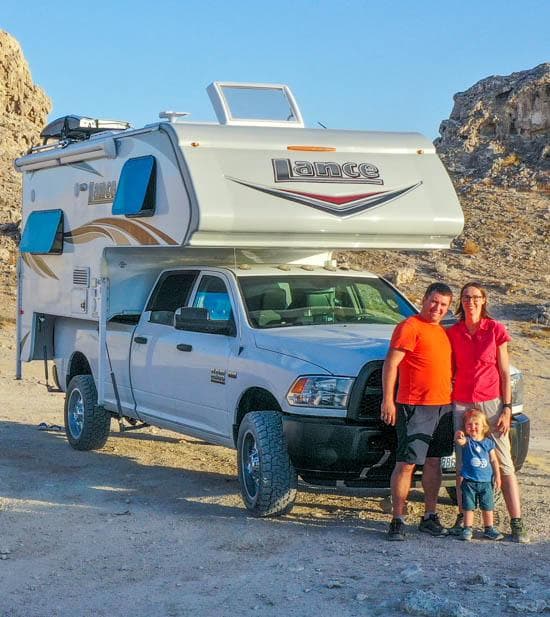
Today, if we can continue this adventure, it is above all thanks to our blog, Smartrippers! We created it one day in 2016, with the desire to share our good travel tips, without thinking that it would lead us there! We have developed it a lot over the years and have become experts on our 3 favorite destinations: Hawaii, Iceland and the American West. We now guide you to these destinations to help you plan the trip of your dreams!
Follow our adventures!